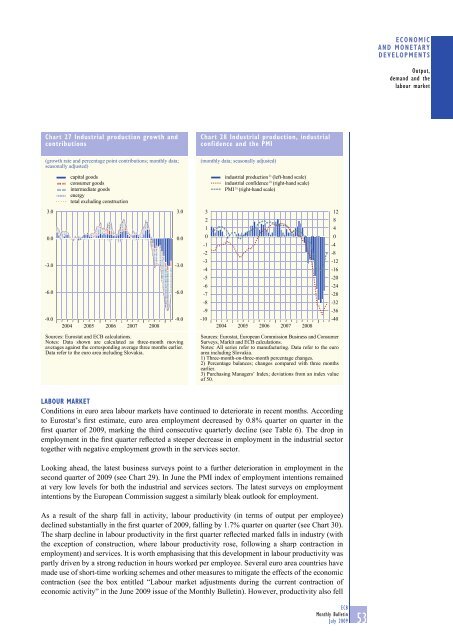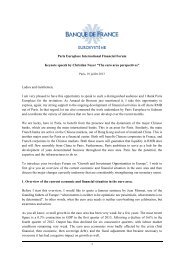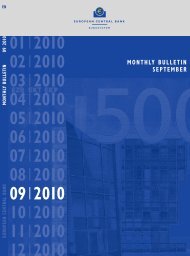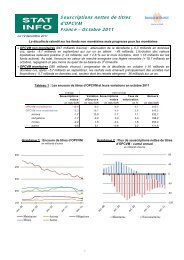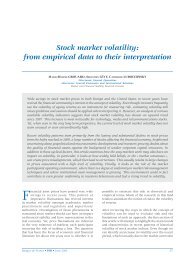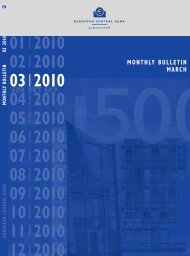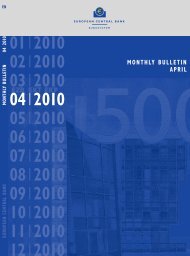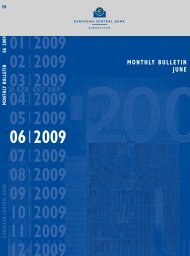Monthly Bulletin July 2009 - Banque de France
Monthly Bulletin July 2009 - Banque de France
Monthly Bulletin July 2009 - Banque de France
You also want an ePaper? Increase the reach of your titles
YUMPU automatically turns print PDFs into web optimized ePapers that Google loves.
ECONOMIC<br />
AND MONETARY<br />
DEVELOPMENTS<br />
Output,<br />
<strong>de</strong>mand and the<br />
labour market<br />
Chart 27 Industrial production growth and<br />
contributions<br />
Chart 28 Industrial production, industrial<br />
confi<strong>de</strong>nce and the PMI<br />
(growth rate and percentage point contributions; monthly data;<br />
seasonally adjusted)<br />
capital goods<br />
consumer goods<br />
intermediate goods<br />
energy<br />
total excluding construction<br />
(monthly data; seasonally adjusted)<br />
industrial production 1) (left-hand scale)<br />
industrial confi<strong>de</strong>nce 2) (right-hand scale)<br />
PMI 3) (right-hand scale)<br />
3.0<br />
0.0<br />
-3.0<br />
-6.0<br />
-9.0<br />
2004 2005 2006 2007<br />
2008<br />
3.0<br />
0.0<br />
-3.0<br />
-6.0<br />
-9.0<br />
3<br />
2<br />
1<br />
0<br />
-1<br />
-2<br />
-3<br />
-4<br />
-5<br />
-6<br />
-7<br />
-8<br />
-9<br />
-10<br />
2004 2005 2006 2007<br />
2008<br />
12<br />
8<br />
4<br />
0<br />
-4<br />
-8<br />
-12<br />
-16<br />
-20<br />
-24<br />
-28<br />
-32<br />
-36<br />
-40<br />
Sources: Eurostat and ECB calculations.<br />
Notes: Data shown are calculated as three-month moving<br />
averages against the corresponding average three months earlier.<br />
Data refer to the euro area including Slovakia.<br />
Sources: Eurostat, European Commission Business and Consumer<br />
Surveys, Markit and ECB calculations.<br />
Notes: All series refer to manufacturing. Data refer to the euro<br />
area including Slovakia.<br />
1) Three-month-on-three-month percentage changes.<br />
2) Percentage balances; changes compared with three months<br />
earlier.<br />
3) Purchasing Managers’ In<strong>de</strong>x; <strong>de</strong>viations from an in<strong>de</strong>x value<br />
of 50.<br />
LABOUR MARKET<br />
Conditions in euro area labour markets have continued to <strong>de</strong>teriorate in recent months. According<br />
to Eurostat’s first estimate, euro area employment <strong>de</strong>creased by 0.8% quarter on quarter in the<br />
first quarter of <strong>2009</strong>, marking the third consecutive quarterly <strong>de</strong>cline (see Table 6). The drop in<br />
employment in the first quarter reflected a steeper <strong>de</strong>crease in employment in the industrial sector<br />
together with negative employment growth in the services sector.<br />
Looking ahead, the latest business surveys point to a further <strong>de</strong>terioration in employment in the<br />
second quarter of <strong>2009</strong> (see Chart 29). In June the PMI in<strong>de</strong>x of employment intentions remained<br />
at very low levels for both the industrial and services sectors. The latest surveys on employment<br />
intentions by the European Commission suggest a similarly bleak outlook for employment.<br />
As a result of the sharp fall in activity, labour productivity (in terms of output per employee)<br />
<strong>de</strong>clined substantially in the first quarter of <strong>2009</strong>, falling by 1.7% quarter on quarter (see Chart 30).<br />
The sharp <strong>de</strong>cline in labour productivity in the first quarter reflected marked falls in industry (with<br />
the exception of construction, where labour productivity rose, following a sharp contraction in<br />
employment) and services. It is worth emphasising that this <strong>de</strong>velopment in labour productivity was<br />
partly driven by a strong reduction in hours worked per employee. Several euro area countries have<br />
ma<strong>de</strong> use of short-time working schemes and other measures to mitigate the effects of the economic<br />
contraction (see the box entitled “Labour market adjustments during the current contraction of<br />
economic activity” in the June <strong>2009</strong> issue of the <strong>Monthly</strong> <strong>Bulletin</strong>). However, productivity also fell<br />
ECB<br />
<strong>Monthly</strong> <strong>Bulletin</strong><br />
<strong>July</strong> <strong>2009</strong><br />
53


